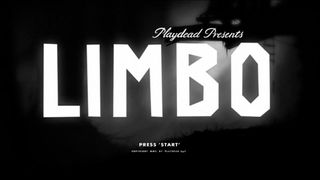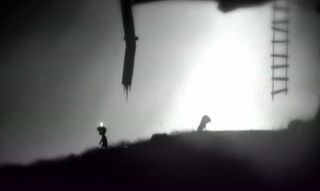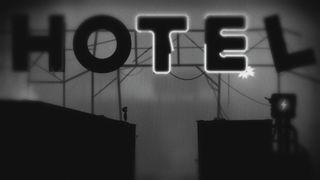Limbo: what does it all mean?
Six different takes on the game's ambiguous end
So for Limbo, I won't do a Google search, and I won't rely on obscure, vague clues not obvious during a typical playthrough. Which leaves me only with the title, and the simple conclusion that Limbo is, well… limbo. As in, the usual definition of that word: "an unknown intermediate place or condition between two extremes," or if you're religious, "a state of afterlife between Heaven and Hell."

The details are up for interpretation and ultimately unimportant. Perhaps our protagonist was really a little boy in life, or perhaps this is an adult working through childhood issues after death. Perhaps he actually did something terrible while alive to deserve such repeated and violent punishment, or perhaps these are metaphorical obstacles that anyone faces. Perhaps the girl he's chasing was really a sister he lost, or hurt, as the Xbox Live description hints. Perhaps she's standing in for every woman he ever lost and hurt. Or perhaps she's just a symbol for his lost innocence.

Perhaps, perhaps, perhaps. I don't care for specifics. All I need to know is that the character is trapped in an eternal (and, if the constant fatalities and full-circle ending are any indication, eternally repeating) state of dream-like trial-and-error until he can finally move on to the next stage of existence. Or non-existence. Or whatever. Limbo is a powerful game, with or without meaning. Going by my experience with Braid, "without" might be preferable.

I’ve gotta side with Charlie and Eric on this one. The “meaning” seems pretty obvious, but if I go into overanalyze mode and try to assign deeper meaning to some of the game’s events, I come up with this.
The whole game is one of those split-second life-flashing-before-your-eyes things, where you have re-live your life or come to some startling revelation about your life right as you die. In this case, I think the boy is the manifestation of a dying industrialist who’s turned his back on his rural upbringing, created an industry of pollutants and bellowing smoke, and in the pursuit of this capitalist dream he’s alienated his family, represented by his sister.
You begin in a grassy, natural area. That’s where he grew up, and the fearful spider and other animals terrify him because they’re something he can’t control. The natives who fight back are your hometown friends and neighbors, who view you as a traitor and someone whose ambitions will one day be the end of him.

As he progresses, he leaves the outdoors behind and enters a loud, modern area with crackling electricity and rundown buildings devoted to producing… something. Anything, really, just industry going full steam ahead. The point of no return is in Chapter 9, when you use the frog to spin the gear that makes it rain. This represents the man’s complete descent into control, that in his mind he’s risen so high that he could bend nature to his will. He put the frog (nature) to work in a gear (industry), enslaving his past to his present.
Sign up to the GamesRadar+ Newsletter
Weekly digests, tales from the communities you love, and more

After more urban areas, each becoming more devious and treacherous, you eventually bump into your sister. This being the first time you’ve seen her in forever, instills a strong desire to approach her. But as you near, the head maggot falls down and turns you away. I think these maggots are the boy/man’s conflicting thoughts about his decisions – one side says “turn back, you need to revert to your wholesome ways!” while the other always pushes you forward. These moments of indecision end anytime you step into the light, which has forever been the international sign of an idea solidifying. He’s set walking one way, then he firmly changes his mind (that’s the light), and goes the other way. Before long though, another thought creeps up and he’s caught in a back-and-forth between his own desires. And then, when walking back to your sister, you find she’s gone, now leaving your life, seemingly for good. Your past is completely behind you.

These conflicting thoughts, about whether you’ve made the right choice by abandoning your past, are represented by the traps and the deaths you suffer. You’re beating yourself up the whole time, always a sliver of doubt about your life’s zealous path. By the time you reach the very, very end, you’re flipping the levels all over the place. Up is down, down is up and so on. This reflects the boy/man’s effort to finally figure out where he stands – is his past over, his family and friends a relic, or is this continued life of cold machinery more important? That last puzzle, where you break through the wall, is him finally shattering his old view and changing perspectives, realizing that he’s been wrong to exile his family for power, and only then can he approach his sister. Credits, then back to that scene, where both the boy and the girl are gone. That’s him realizing he could never really let go of his family. And now that the flash is over, he finally dies, reverting this game back to the title screen, which also happens to suggest a grave site. Likely yours.
Oh, Limbo. You and your black, white, and shades of gray–ness. When I played through the game, I took the entire romp as a very simple tug on the heart strings wordlessly told through movement, sound, and mechanics. Even the poignant ending with its silent acceptance that maybe the Boy had finally met up with his Sister…or maybe he hadn’t? Either way, I didn’t care. I thought it was a giant love poem to keeping things simple; not cluttering it all up with bombastic OVER-MEANING. There weren’t giant neon signs (except for that hotel one, of course) telling me YOU SHOULD BE FEELING LOSS, DESPAIR, PROFOUND MEANINGLESSNESS IN THE VOID OF HUMAN CONTACT. No, it was meant to taken at face-value in a way.

But then came all the theories with their “could he have been killed in a car crash and tossed through a windshield like when he breaks through the glass in the final scene and his sister is actually mourning his loss at his gravesite?” ponderings and allusions to dual graves in the title screen. After all, there are two clumps of flies hovering ever so obliquely over two distinct patches of soil, right?

I love every single one of these thoughtful theories. I love the fact that something so simple like the journey of a boy in a phantasmagoric world in search of…something, someone, can go all origami-like in its interpretations once it’s fallen into the hands of gamers — or better yet, “readers.” It’s brilliant. It got me thinking of the stages of the game itself: from the wilderness with its natural adversary in the form of a spider, then moving into human settlements with huts and primal-seeming homicidal children, and onto the cold, mechanical backdrops of the modern world with no hint of humanity, just cogs, gears, and the impersonal buzzing of electricity and chainsaws.
I’m not entirely convinced that Playdead set out to create some sort of interactive example of postmodern literature, but it’s exactly like one professor told me when he was grading my paper in an English class: “Instead of using ‘lifestyle’ when you’re writing, just use ‘life.’ The meaning goes from narrow to wide-open and multi-layered.” Limbo took that lesson and ran with it.
What do you think? Straightforward presentation of limbo, an allegorical account of someone’s life, or just a game trying to look meaningful? Let us know your thoughts below!
Jul 29, 2010


Solve every puzzle and get every point with our complete guide

A genuine masterpiece. Part platformer, part puzzler, but more than either.
GamesRadar+ was first founded in 1999, and since then has been dedicated to delivering video game-related news, reviews, previews, features, and more. Since late 2014, the website has been the online home of Total Film, SFX, Edge, and PLAY magazines, with comics site Newsarama joining the fold in 2020. Our aim as the global GamesRadar Staff team is to take you closer to the games, movies, TV shows, and comics that you love. We want to upgrade your downtime, and help you make the most of your time, money, and skills. We always aim to entertain, inform, and inspire through our mix of content - which includes news, reviews, features, tips, buying guides, and videos.
Most Popular


